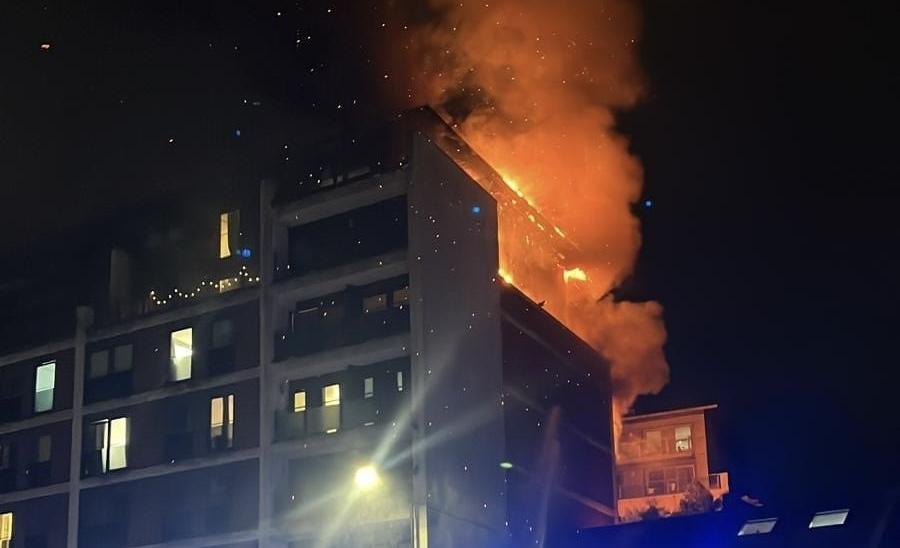From artisanal crepes to rebellious cheesecake waffles, Reading's breakfast rebels are transforming morning meals. These seven spots will revolutionize how you start your day.
In a disturbing revelation, it has come to light that dangerous cladding similar to that used on Grenfell Tower was installed on parts of the Mosaic Apartments building on Slough High Street. This discovery follows a recent fire at the residential complex, raising serious concerns about fire safety in urban developments.
Echoes of Tragedy: Cladding Controversy Resurfaces
The presence of Grenfell-style cladding on a building that has experienced a fire incident is a stark reminder of the tragic events at Grenfell Tower in 2017. This finding underscores the ongoing challenges in ensuring fire safety in residential buildings and the potential risks faced by occupants of structures fitted with such materials.
Fire Incident at Mosaic Apartments

Last week, a fire broke out at the Mosaic Apartments building on Slough High Street, drawing immediate attention to the structure's safety features. The incident, while alarming, fortunately did not result in any reported casualties. However, it has sparked a crucial investigation into the building's construction materials and fire safety measures.
Discovery of Dangerous Cladding
In the aftermath of the fire, a disturbing revelation came to light. Parts of the Mosaic Apartments building were found to be fitted with dangerous cladding similar to that used on Grenfell Tower. This discovery has sent shockwaves through the community and raised serious concerns about the safety of residents living in the complex.
The presence of such cladding is particularly alarming given the tragic events at Grenfell Tower in 2017, where the rapid spread of fire was attributed to the building's exterior cladding. The use of this material on the Mosaic Apartments suggests that lessons from the Grenfell disaster may not have been fully implemented in some construction projects.
Implications for Resident Safety
The revelation of Grenfell-style cladding on a building that has experienced a fire incident underscores the potential risks faced by occupants of structures fitted with such materials. It raises questions about the thoroughness of building inspections and the enforcement of safety regulations in the years following the Grenfell tragedy.
Residents of the Mosaic Apartments may now find themselves grappling with concerns about their safety and the need for urgent remediation work. The incident serves as a stark reminder of the ongoing challenges in ensuring fire safety in residential buildings, particularly in urban developments where many people live in high-rise structures.
Calls for Action and Investigation
The discovery of this dangerous cladding is likely to prompt calls for a comprehensive review of fire safety measures in buildings across Slough and potentially wider areas. Local authorities and building management companies may face pressure to conduct thorough inspections of similar structures to ensure they meet current safety standards.
Furthermore, this incident may reignite debates about the responsibility for removing and replacing dangerous cladding, a issue that has been contentious since the Grenfell Tower fire. Questions about who should bear the cost of such remediation work – building owners, developers, or government bodies – may once again come to the forefront of public discourse.
As investigations into the Mosaic Apartments fire continue, the focus will undoubtedly be on determining how this type of cladding was allowed to be used on the building and what measures can be taken to prevent similar occurrences in the future. The incident serves as a critical reminder of the importance of stringent building regulations and the need for ongoing vigilance in matters of fire safety.
Renewed Focus on Building Safety Regulations
The discovery of Grenfell-style cladding on the Mosaic Apartments has reignited discussions about the effectiveness of current building safety regulations. This incident highlights potential gaps in the implementation and enforcement of safety standards, particularly in the years following the Grenfell tragedy. It raises questions about whether existing regulations are sufficiently robust to prevent the use of dangerous materials in construction projects.
Local authorities may now face pressure to review and potentially strengthen their building inspection processes. This could lead to more rigorous checks on construction materials and fire safety measures, not only for new developments but also for existing structures that may have been overlooked in previous assessments.
Impact on Property Market and Insurance
The revelation of dangerous cladding on a prominent High Street building could have far-reaching consequences for the local property market. Potential buyers and renters may become more cautious about investing in or living in high-rise buildings, particularly those constructed or renovated in recent years.
Insurance companies may also reassess their policies and premiums for buildings with similar profiles. This could lead to increased costs for building owners and, potentially, residents if these expenses are passed on through higher rents or service charges.
Community Response and Resident Support
The incident at Mosaic Apartments is likely to mobilise community action and support networks. Residents' associations and local advocacy groups may form or strengthen to ensure their voices are heard in discussions about building safety and remediation efforts.
Support services may need to be put in place to assist residents dealing with the psychological impact of living in a building now known to have fire safety issues. This could include counseling services and assistance in navigating potential relocation processes if deemed necessary.
Long-term Implications for Urban Development
This event may influence future urban development strategies in Slough and beyond. There could be a shift towards more transparent construction practices, with increased emphasis on publicly accessible information about building materials and safety features.
The incident might also accelerate the adoption of innovative fire-resistant materials and construction techniques in new developments. This could lead to advancements in building technology and potentially reshape the approach to urban architecture with a stronger focus on safety alongside aesthetics and functionality.